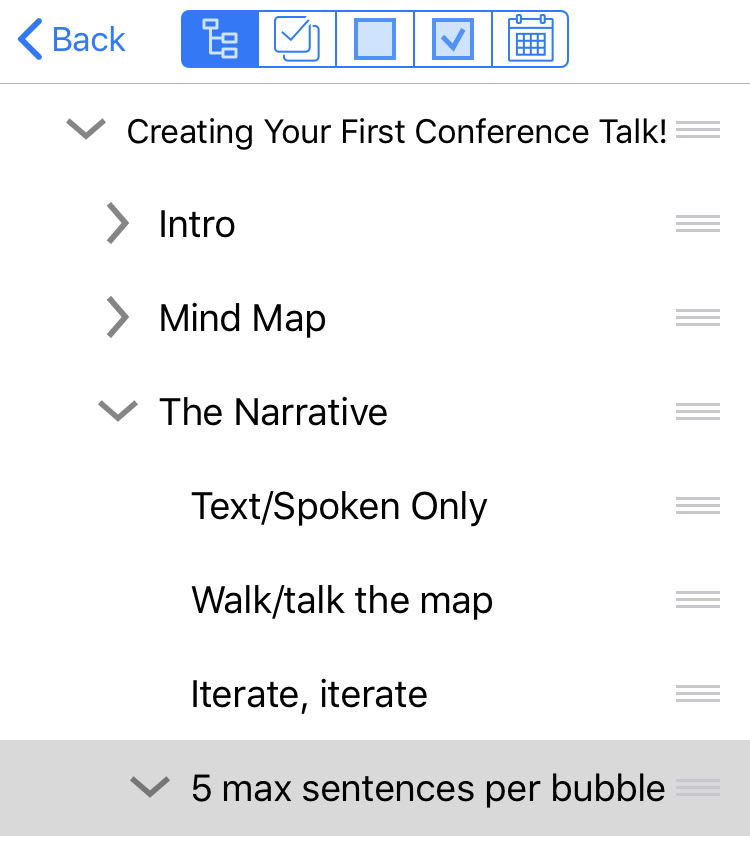How To Survive Your First Conference Talk
Does any of this sound familiar?
- You chose a conference that looked like it had interesting people and topics.
- You wrote 1 (or more) proposals about something you wanted to share, or learn about.
- To your surprise, you were chosen to present at the conference!
- Now, that sinking feeling - Oh crap, How am I going to pull this off?
When I found out I'd be presenting at RxJS Live, and had only 3 days to flesh out the talk, I was excited, but quite anxious. But when I pulled it off, I realized I needed to share with others who might be in similar need.
If you're a person who likes to follow a recipe, I'll suggest one that you can use. It's an idealized version of the process that I followed. I followed a process since there was no time to be lost. I think it helped me create a talk that was:
- Organized
- Well-Paced
- Able to be spoken clearly
Some things, I won't cover in this post, however:
- How much time to spend on each part of your preparation
- What your topic is, or how deep to go
- How to use voice and body language effectively
But I will go over each section of preparing you'll need to do, and leave you some simple, easy take-aways in each section.
Also, if you want to learn from someone who's done this far more than me, I can recommend Justin Searls' well-illustrated Crafting A Conference Talk.
Now, let's dig in!
Mind Map It
The first thing you need to do is decide what you will, and won’t cover. The biggest risk to you, dear presenter, is overcommitting to material. The best thinking tool I’ve found for organizing possible topics is a Mind Map. Used correctly it will be fast, fun, and allow you to know when you’ve got enough, or too much.
A mind-map is a 2-D layout of your topics that you build organically. There's actually a specific definition of Mind Map, with neuro-science based rules and articulated benefits, which you can read about in The Mind Map Book. But for now, use any portable tool - pencil & paper, or the really awesome SimpleMind app. I can't recommend SimpleMind enough - it's intuitive, stays out of my way, and allows me to edit on the go, and in airplane mode! Here's a mind map of this blog post:
Advice for mindmapping:
What to do:
- Exploit the freedom to add topics in any order
- Keep descriptions of bubbles ("topics") short
- Create neighborhoods ("topic groups") of topics
- Actually physically walk around, speaking out loud as though presenting, but without pressure. It's fun! :)
What not to do:
- Decide exactly what to say for each topic
- Obsess about images or wording
- Let stress build up about the finished product
A good rule of thumb is to have one topic on your mind map per minute of time you have to fill. In my case I had a 30 minute talk. Here's an intentionally blurred picture of the Map of the talk I gave, so you can just see the shape and organization:
The visual weight of each area shows whether your talk's sections are roughly balanced. It takes 3-6 topics to create a memorable story-arc of introduction, elaboration, and resolution. So about 5-6 topics can give a feeling of progress without belaboring things. Too small, and a topic group will be forgotten, so each one needs a little meat on its bones. Many memorable songs have that many sections - a couple verses, choruses, a bridge. If each topic group is as memorable as a Beatles song, you'll be just fine :)
Done with your mind map? Great! Now, we need to put topics in an order that unifies them, and allows for smooth transitions. This is incredibly important, so let's get on it..
The Narrative - Topic Order
2-D is fun for brainstorming, but your talk must be given linearly. So now you have to settle on an order, and iterate it until it is smooth.
What you are going to do, is talk through your mind map, saying at least a few sentences that you want to say for each topic. You can do this as many times as you like, refining your mindmap as needed. It's best to debug the topic order now than once you've started building within an order.
SimpleMind wins here, by being able to turn your mindmap into an outline. You can reorder this outline, and STILL keep the exact visual grouping of the mindmap! Again, from the mindmap of this post:
Talk around your mindmap a few times, from topic to topic, until you arrive at the same order every time. This may require multiple sessions to do this, and that's OK! Moving on while it's still shaky will be disastrous and cost you time you don't have. Writing your narrative and choosing images is all that's left to do after this, and that can be done under the gun, but massive re-orderings cannot!
Proceed to writing your Talking Points only when ready.
The Narrative - Talking Points
Now that the topic order is set, you'll want to get down to writing down those talking points that you came up with while walking your map. You will generally be talking continually, but with pauses, throughout your talk. This means each topic needs words, and words work better in sentence, of course! So you're going to write sentences - approximately 5 per topic.
The rule of thumb for this is:
5 sentences max per topic, and 15-20 words per sentence!
There's a reason for these numbers. But don't worry about that yet. For now, your goal is simply to capture those thoughts you had that determined the topic order. The process of writing out each sentence will do a lot for you. The more you can commit to the exact words you'll use, the more professional and polished you'll sound. Maybe you don't have time for that now, but at least try to create sentences that feel right, and are authentically you. 5 sentences of 15-20 words, based on a speaking pace of 120-150 words per minute, leaves room in your word-budget that you can turn into pauses, or improvise in later.
Now get down to it!
What to do:
- Re-walk your mind map, writing down the sentences that helped you determine your topic order
- Using a text editor, keep sentences short enough so they fit on one line.
What not to do:
- Write your sentences when the topic order is not solid.
- Lay these words out as bullet points on slides (keep them Presenter Notes or in a separate application like a text editor)
Visuals/Slides
Congrats - you are in the home stretch! For my 30 minute talk I did the previous steps over 2 days, during transit, waiting in line— anywhere I could. This final step I did in 2 1/2 unbroken hours after the first day of the conference, and the day before I went on. Finding/making images and memes, choosing props - I find this to be so fun. It's where the palms start to sweat from excitement, not just nerves!
Starting from each topic group, practicing each topic's sentences aloud, ask yourself what your audience should be seeing. Each of these methods, and others can be considered:
- A Lone Image
- Bullet Points
- A code sample
- An audience demonstration or poll
With 30 topics or more, your audience needs variety: each one cannot be delivered in the same way! Your content, and how much time you have to prepare, will determine exactly what you commit to showing or playing. But, variety will make things far more memorable. And the last thing you want after all your hard work is for your message to be forgotten.
What to do:
- Talk over each topic group with images as it gets completed.
- With a stopwatch, time each section with the exact words and support visuals to verify it still works with the narrative
- Practice! Practice!
What not to do:
- Try a brand new presentation software if you're pressed for time.
- Get a big idea to add or rewrite more than 1%
- Freak out and call the whole thing off (really?)
Remember WHY this was important enough to you to do this.
Remember WHAT you love about this topic.
Remember HOW you want to make things better for your audience.
At the end they're not judging your slides, or even you. They want to reach a new level of understanding, feel smarter, enlightened, aware. You can only do your best. But you are there for a reason, and it's really out of your hands once you've gotten to this point. So trust-fall into the universe once you've prepared this much. You got this! (Let me know how it goes)











Latest comments (0)